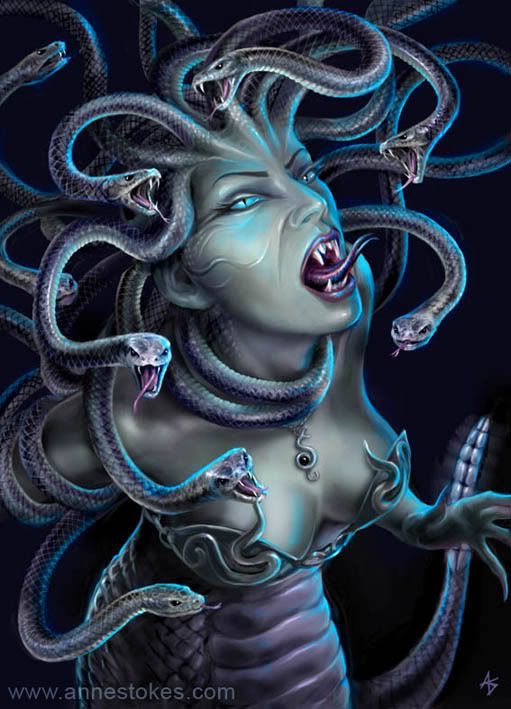
 i n Greek mythology, Medusa "guardian, protectress, queen". Her name probably derived from the feminine present participle of medein, "to protect, rule over".), a sea nymph, was one of three gorgon sisters, and the most beautiful. She was courted by Poseidon, and made love to him in a temple of Athena. Furious, Athena transformed Medusa into a monstrous chthonic beast with snakes instead of hair, whose frightening face could turn onlookers to stone. She was beheaded by the hero Perseus, who thereafter used her head as a weapon until giving it to the goddess Athena to place on her shield. Having coupled with Poseidon previously, two beings sprang from her body when she was beheaded. One, Pegasus, was a winged horse later tamed by Bellerophon to help him kill the chimera. The other, Chrysaor of the Golden Sword, remains relatively unknown today. In classical antiquity and today, the image of the head of Medusa finds expression in the evil-averting device known as the Gorgoneion
i n Greek mythology, Medusa "guardian, protectress, queen". Her name probably derived from the feminine present participle of medein, "to protect, rule over".), a sea nymph, was one of three gorgon sisters, and the most beautiful. She was courted by Poseidon, and made love to him in a temple of Athena. Furious, Athena transformed Medusa into a monstrous chthonic beast with snakes instead of hair, whose frightening face could turn onlookers to stone. She was beheaded by the hero Perseus, who thereafter used her head as a weapon until giving it to the goddess Athena to place on her shield. Having coupled with Poseidon previously, two beings sprang from her body when she was beheaded. One, Pegasus, was a winged horse later tamed by Bellerophon to help him kill the chimera. The other, Chrysaor of the Golden Sword, remains relatively unknown today. In classical antiquity and today, the image of the head of Medusa finds expression in the evil-averting device known as the GorgoneionThe Myth of Medusa the Monster
In the Athenian myth of the Greek hero Perseus, Medusa's female wisdom along with the potential of women in general is silenced and the forces of nature are conquered in an ultimate act of domination and vengeance.
Perseus is sent on a quest, by King Polydictes of Seriphos and Athena herself, to retrieve the head of the Gorgon, a deed said to require the maximum of heroic-male courage and skill. He is given magic winged sandals, a cap and a pouch,(a kibisis), from Hermes. Guided by Athena the entire time, he flies over the ocean to Lake Tritonis in Libya where makes his way through rough, thick woods. On the way to Medusa's palace he sees several statues of men and beasts. There are also stone pillars erected in honor of her deceased lovers. Perseus comes upon the sleeping Gorgons. While Athena holds out a shield as a mirror, Perseus decapitates Medusa with his crescent sword,(a harpe). Enraged, the Gorgon sisters chase after him but to no avail as his cap makes him invisible.
Perseus could not have completed this task without the help of the traitor warrior goddess Athena. It is she who guides and instructs him throughout his journey and slaying. Since the myth symbolized the usurping of her powerful roots in a culture where she and Medusa were one, it is appropriate that only she would know the secrets to find and defeat Medusa.
The Blood of Medusa:
Even in death Medusa's blood retains its powers. It gives life to Pegasus, the winged, militant steed of Zeus that creates serpents in the earth with the touch of his hoof, and who also introduced Dionysiac worship to Athens. Also Chrysaor, the golden bladed giant, is born from her bleeding neck. Medusas' blood is drained from her body and later used to raise the dead, (making Asclepius a great healer). Used from her right vein it heals and nourishes life, from her left serpent it kills.
The snakes, her dreaded face, her look of stone, and her magical blood all correlate with the ancient menstrual taboo. Primitive folk believed that the look of a menstruating woman could turn a man to stone. Menstrual blood was also thought to be the source of all mortal life and also of death, as the two are inseparable.
The Head of Medusa:
Perseus puts Medusa's head into his pouch. He uses her head as a weapon during other exploits and when he reaches home he returns it to Athena. The head of Medusa is then wrought onto the center of Athena's aegis and Zeus's shield which is given to Athena. Even after her defeat, the face of Medusa forever maintains its Gorgon power to protect the Goddess from enemies by turning them to stone. It is the striking, central image on renderings of Athena. Medusas' face continues to symbolize her fierce strength in military ritual and in battle on the warriors' armor.
APPEARANCE OF MEDUSSA IN THE FILM CLASH OF THE TITANS









![[01162010825.jpg]](https://blogger.googleusercontent.com/img/b/R29vZ2xl/AVvXsEgYQDKJLOF0ltpy7pUqS0aIZN4Qz0msjSY5TuT17HtNF5l2CHoH_nD3RisaQyC-LuFraITbtrF-h1H4irenjz4M59RheCCsXoxEFRJosPv4L0iuJH_t7-fBj3fe-4COK5c-GE-bNWKfY3DG/s220/01162010825.jpg)



![[butterfriend.jpg]](https://blogger.googleusercontent.com/img/b/R29vZ2xl/AVvXsEiSAYSHoJRFb68lGNDSSL_A0BkqonAj7iCpGEfy56DXmqCFtXCi-7-s76NAV8TW1w38G2bjZCLvdlf9AodCA7AnzrCYrZZS51SxlbARiHaBWxIkYZ_4Y2fqycgqmw6dyWpNECApGAbgleey/s220/butterfriend.jpg)
![[Copy+of+Tekkaus-Thumbnail+new+Large.jpg]](https://blogger.googleusercontent.com/img/b/R29vZ2xl/AVvXsEh2A0iapNYYs722KK3yPo7UfbE4XQw12Hw2iwFxzLRRFOt1Z3xvHr7p9KS_AII4k178CkQm3jzd9g0xX6XV916YtksxoSarlTTd_LKw9e3VbsRBGo_9hUnIg8qh7GVuaF-LLzGmojJ8QGa4/s220/Copy+of+Tekkaus-Thumbnail+new+Large.jpg)



